
Here we offer an analysis of mental illness expressed in the work of a key twentieth century author: Virginia Woolf. A critical review of her literary legacy allows us to get closer to what might be one of the most intense literary portrayals of illness and its metaphors and, at the same time, to the representations, euphemisms, silences, and monsters depicted in the chapters of her life and in the unique voice of this essential author.
Keywords: illness, literature, writing, Virginia Woolf, women.
Introduction
Most of the pathologies we suffer are often overburdened with mythology. Since ancient times, speculations about illness present it as an instrument of divine wrath or unknown obscure forces (think, for instance, about the plague that Apollo inflicted upon the Achaeans in the Iliad as a punishment for the abduction of Chryses’s daughter by Agamemnon). In fact, any condition considered a mystery at a given moment is perceived as morally suspicious; the name is even omitted in order to avoid unexpected danger – the protagonist’s mother in Armance, by Stendhal, is an example of this; she avoids the term tuberculosis for fear that uttering it will make her son get worse. Similarly, the evil nature of the word cancer leads many people to avoid or hide it, so sometimes it must be understood implicitly in literature (as in Tolstoy’s The death of Ivan Ilyich).
«Virginia Woolf reflects on illness and how it makes us contemplate the universe in a very different way»
In this work, we journey through the disorders and illness of Adeline Virginia Stephen, better known as Virginia Woolf. Her fiction – but also in her essays, diaries, and memoirs – reveals her profound ability for introspection, but also documents an insider’s perspective of illness, its related states of mind, and psychological highs and lows. This information is complemented with documents from the author’s most intimate circle, who outline her clinical and everyday universe – which are sometimes difficult to separate.
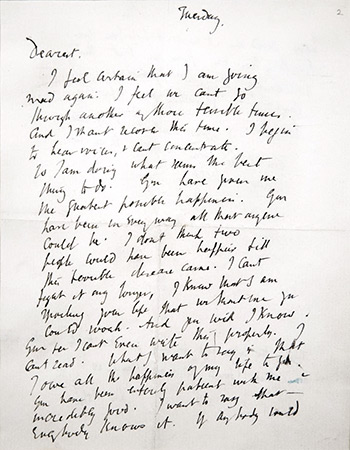
Picture with part of the letter Virginia Woolf left for her husband Leonard before she committed suicide. / Open Culture
Crises
There has been ample discussion on Virginia Woolf’s condition. Today experts think she had bipolar disorder with hypomanic dysphoria and severe depressive phases (American Psychiatric Association, 2000; Baldessarini, 2000). She suffered the three major crises of her disease in the summer of 1895, May 1904, and July 1913, although she went through other severe episodes between these periods. She had the first episode when she was thirteen. It left her convalescing for over six months and forced her to stop writing her diary, which she had started four years before. In 1897, after an intense breakdown, she says that life was very hard for her and that she would need elephant hide to endure it, which the writer certainly believed she did not have (Woolf, 1975). The second severe episode, in 1904, was very serious and led to her first suicide attempt. However, the most acute period in her disorder extended from 1913 to 1915. Despite her significant instability, she married Leonard Woolf in August 1912. At the time, she had intense ups and downs, as reflected by her intake of 100 grams of Veronal on 9 September 1913, in another attempt to take her own life.
Her collapses, nightmares, and breakdowns would continue until summer 1915. Then, against all odds, she was quite well until 1936 (Woolf, 1980). In 1941 she again felt rather dejected, and was afraid that her illness would get worse again and she would have to go to an asylum as on previous occasions. In fact, she was hearing voices – the preamble to a severe crisis – and on 28 March, after writing two farewell letters, one to Leonard and the other to her sister Vanessa, she walked into the river Ouse with her overcoat pockets full of stones. This was her last attempt to take her own life, and this time she was successful. This is a fragment of her letter to Leonard:
Dearest, I feel certain that I am going mad again. I feel we can’t go through another of those terrible times. And I shan’t recover this time. I begin to hear voices, and I can’t concentrate. So I am doing what seems the best thing to do. You have given me the greatest possible happiness. You have been in every way all that anyone could be. I don’t think two people could have been happier ‘til this terrible disease came. I can’t fight any longer. I know that I am spoiling your life, that without me you could work. And you will I know. You see I can’t even write this properly. I can’ read.
(Bell, 1996, p.226)
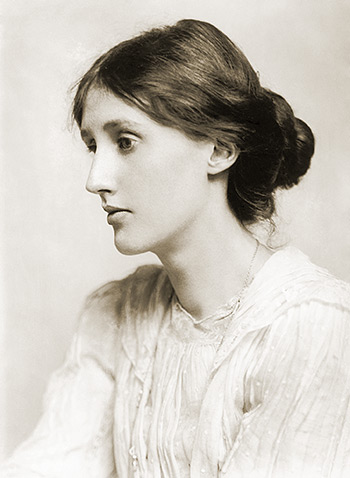
There has been ample discussion on Virginia Woolf’s illness. Experts now think that she had bipolar disorder with hypomanic dysphoria and severe depressive phases. Above, Virginia Woolf’s portrait, painted in 1902 by George Charles Beresford. / George Charles Beresford / Wikimedia
Freud and Woolf
Sigmund Freud and Virginia Woolf did not personally meet each other until 28 January 1938 in their retirement in Hampstead, a year before Freud’s death and three before she passed away. A few months before, Freud had arrived in England, weak, worn, and tired due to the jawbone cancer he had long suffered. During the visit, Virginia Woolf was excited by the analyst’s sharp intelligence. But as far as we know, the author was never psychoanalysed. At that time her diagnosis was manic-depressive disorder, and the episodes were treated with sleep cures, a balanced diet, and quiet environments, although she barely slept and ate even less.
One must wonder why she was not psychoanalysed, especially given that Leonard Woolf admired the Viennese doctor (the married couple published Freud’s work in Hogarth Press1, taking both an economic chance and risking being accused of obscenity by the establishment). While Virginia was always quite unyielding to the ideas of psychoanalysis, she progressively changed after visiting Freud, as we can see from her diary entries months after the professor from Vienna passed away. On 2 September 1939, she said she had started to devour Freud’s work (Woolf, 1985). She never stopped reading his books, which would be reflected in her work, as seen in Moments of being (Woolf, 2013). In a way, Virginia Woolf responded to the power that the father of psychoanalysis assigned to the past and to primitive emotions hidden under the guise of culture.
«At many times in her writing, especially in her autobiographical work, Woolf comments on the need to use creation as an escape from illness»
A heavy emotional burden
The writer’s existence was marked by events caused by an onerous emotional burden. The first of these loads was the result of her mother’s passing, for which she blamed herself her entire life. She also carried the guilt of the death of her father, Sir Leslie Stephen, and of other people she was close to and who passed away during this period. In this sense, one of the key events was the death of her half-sister Stella from peritonitis while pregnant. This had a severe consequence: Woolf’s father forbade Stella’s name from being uttered again. Having to remain silent about her emotions made it impossible Woolf to accept her grief. The prohibition also explains the subsequent poor relationship between Sir Leslie Stephen and his children. Her father’s death in 1904 created more feelings of guilt and she started hearing voices telling her to do insane things, until she finally jumped out of a window, albeit with no serious consequences. In 1906, her favourite brother, Thoby, died from typhoid fever while returning from a trip to Greece.
The third episode is quite well-documented, among other reasons, thanks to Leonard’s detailed diary of his wife’s disorders, which includes, for example, her constant fixation of talking for days on end with her deceased mother and father. She felt guilty and thought her distress was a deserved punishment (Figueroa, 2005; García Nieto, 2004). Similarly, some of her life experiences, like the sexual abuse she and her sister possibly suffered at the hands of their half-brothers – Gerald and George Duckworth – might have aggravated her disorder (DeSalvo, 1989).
«Some of her fictional characters show psychological symptoms that she knew very well»
However, most scholars attribute some of her illness to a hereditary factor – an idiopathic root cause, because her grandfather on her father’s side suffered at least three crises. In addition, her cousin, James Kenneth Stephen, also a writer, developed a manic disorder and was confined because of his aggressiveness; her father, Leslie Stephen, a preeminent intellectual, suffered severe episodes of depression, especially after his second wife’s death in 1895; her mother, Julia Duckworth, went into pathological mourning after the death of her first husband; even her sister, Vanessa Bell, suffered a serious depressive episode after losing a child while pregnant, and a major crisis caused by her tempestuous relationship with Roger Fry.
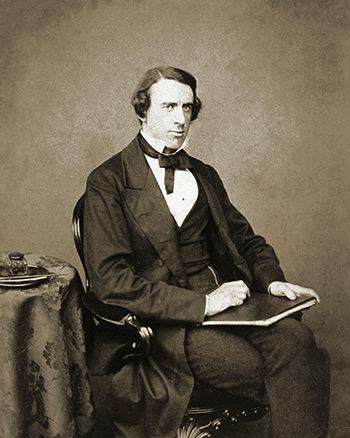
Her father’s death in 1904 generated more feelings of guilt and she started hearing voices inciting her to do insane things. In the photograph, her father, Sir Leslie Stephen, circa 1860.
Writing as therapy
At many times in her writing, especially in her autobiographical work, Woolf comments on the need to use creation as an escape from illness. As she said in April 1929, she considered writing to have a life of its own, and to be a witness of something real beyond appearances, which she could put into words, and in this transformation, they lost their power to hurt her. Writing became a way to escape from what distressed her, what horrified her (Woolf, 2013). Faced with a feeling of vulnerability, creation gave her the protection she sought, as a sort of buffer against the passing of time or the relationships with people she held dear, among others. But when that failed, she fell back into the pit.
In this sense, we can read To the lighthouse (Woolf, 1996) as a psychoanalysis of sorts, with dialogues she never had, as a space to say everything she could not say in life. Minow-Pinkey (1987) has also suggested that the illness of Septimus, the character in Mrs. Dalloway, constitutes a type of verbal insanity, characterised by the loss of the ability to distinguish between signifier and signified, confusing real objects and the words used to refer to them. The disconnect between words and their referents culminates with Septimus’s fall into the black hole of madness after being unable to feel anything for the death of his best friend, just like Virginia, faced with the death of many of her relatives and which was a frequent source of guilt for her.
At the very least, we must note the writer’s preference for water-related imagery, established in her work and her life, as well as her decision to end her life with water. In the pages of some of her books, we observe the relationship between water and nature’s apathy regarding the fate of humans, as well as the peace of death. We can see this in Mrs. Dalloway: «while the sea darkens and brightens beneath him, and the waves which threaten to break, but only gently split their surface, roll and conceal and encrust as they just turn over the weeds with pearl» (Woolf, 2003, p. 61).
«During her first episode of the disease, the author noted that she heard birds singing in Greek, a scene she would recreate years later in ‘Mrs. Dalloway’ and ‘The years’»
In 1925 she wrote a text at T. S. Eliot’s request, «On being ill», to be published in New Criterion in January 1926. In April, the New York magazine The Forum published a shorter revised version titled «Illness: an unexploited mine». In 1930 Virginia and Leonard recovered the original in an edition by Hogarth Press, giving us a text full of depictions of illness and the recurrent approach to the relationship between body and soul. In fact, in one of the first topics, she touches on the suspicious absence of illness among the great literary leitmotifs, and she wonders why literature does not describe the everyday tragedy for body and mind when we are convalescing. She even comments on the lack of words in the English language to reflect pain:
English, which can express the thoughts of Hamlet and the tragedy of Lear, has no words for the shiver and the headache. It has all grown one way. The merest schoolgirl, when she falls in love, has Shakespeare, Donne, Keats to speak her mind for her; but let a sufferer try to describe a pain in his head to a doctor and language at once runs dry.
(Woolf, 2014, p. 29–30)
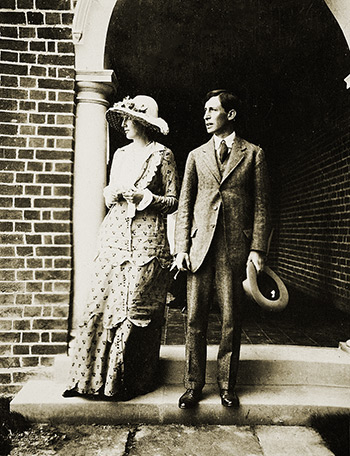
Picture of Virginia and Leonard Woolf in 1912, the year they married. / Wikimedia
She also reflects on illness and how it makes us contemplate the universe in a very different way, discovering aspects of reality that cannot be appreciated or examined from other perspectives: «There is, let us confess it (and illness is the great confessional) a childish outspokenness in illness; things are said, truths blurted out, which the cautious respectability of health conceals. […] In illness, this make-believe ceases. (Woolf, 2014, p. 35–36). Deep down, she outlines the profound loneliness of the human being.
We will not speculate on what her work might have been like without her illness or with treatment in the context of current psychiatric advances, but without a doubt, her personal circumstances affected the way she confronted her existence and her creativity. Some of her fictional characters show psychological symptoms that she knew very well; for instance, Septimus Smith’s anxiety and delirium, which led him to commit suicide, the way doctors – as the guardians of the norm – refer to him as insane, or the existence of Clariss Dalloway. She often pointed to her own experience as the genesis for her fictional texts and, particularly, to her crises, during which ideas and words would flow like a volcano. During her first episode of the disease, the author noted that she heard birds singing in Greek, a scene she would recreate years later in Mrs. Dalloway and The years (Woolf, 1988).
We will not speculate on what her work might have been like without her illness or with treatment in the context of current psychiatric advances, but without a doubt, her personal circumstances affected the way she confronted her existence and her creativity. Some of her fictional characters show psychological symptoms that she knew very well; for instance, Septimus Smith’s anxiety and delirium, which led him to commit suicide, the way doctors – as the guardians of the norm – refer to him as insane, or the existence of Clariss Dalloway. She often pointed to her own experience as the genesis for her fictional texts and, particularly, to her crises, during which ideas and words would flow like a volcano. During her first episode of the disease, the author noted that she heard birds singing in Greek, a scene she would recreate years later in Mrs. Dalloway and The years (Woolf, 1988).
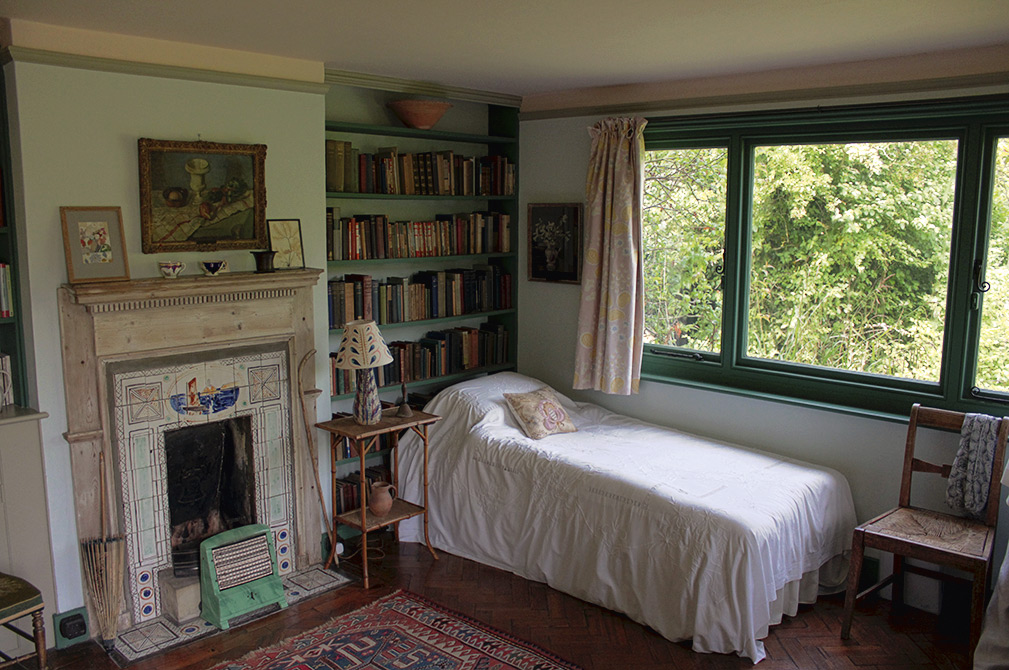
Her diagnosis was manic-depressive disorder, and the episodes were treated at the time with sleep cures, a balanced diet, and quiet environments, although the author barely slept and ate even less. Photograph of the writer’s room at Monk’s House, in her Rodmell countryside retreat in Sussex (England). / John Cummings
«The major episodes she experienced, called “waves” and “horror” in the diary, frequently peaked after the great exertion writing represented for her»
By way of conclusion
A depressive character can be observed both in her writing and in documents written by her closest allies; a sceptical and hopeless character, with recurrent suicidal thoughts and a fear of people. At the same time, she was terrified of loneliness, very self-critical, had constant feelings of guilt, suffered terrible headaches and insomnia, and was often disgusted by food. Some doctors attributed her health problems to literature. Some even recommended that she stop writing, since the major episodes she experienced, called «waves» and «horror» in the diary, frequently peaked after the great exertion writing represented for her. Virginia Woolf never listened to them and, even though her repeated and long attacks of illness affected her work, preventing her from writing for long periods, she had a strong will to create an admirable, vast, and original body of work. Her obstinate and insightful work method surprised even Leonard, her husband and editor, as we can see in his diaries (Woolf, 1970). However, from our modern perspective, her creative work may have helped Woolf to endure her ordeal; in her fight against her hounding illness, literature was the plank she held onto during her constant sinking. In this sense, we can understand the frequent exploration in her last pieces of work of the complexities of one’s self and her analysis of the characters’ consciousness. How could she stop learning about herself, writing about herself, and reading about herself? How could she abandon her own inner journey?
1. Virginia and Leonard’s editorial endeavour, starting in 1917, was no joke: they not only published their own books, but also published essential work by John Maynard Keynes, Edward M. Forster, Fyodor Dostoyevsky, Katherine Mansfield, Anton Chekhov, Thomas S. Eliot, Middleton Murry, and Sigmund Freud, among others. (Go back) References American Psychiatric Association. (2000). Diagnostic and statistical manual of mental disorders. Washington: APA. Baldessarini, R. J. (2000). A plea for integrity of the bipolar disorder concept. Bipolar Disorders, 2, 3–7. doi: 10.1034/j.1399-5618.2000.020102.x Bell, Q. (1996). Virginia Woolf. A biography. London: Hogarth. DeSalvo, L. (1989). Virginia Woolf: The impact of childhood sexual abuse on her life and work. Berkeley: University of California Press. Figueroa, G. (2005). Virginia Woolf: enfermedad mental y creatividad artística. Revista Médica de Chile, 133, 1381–1388. doi: 10.4067/S0034-98872005001100015 García Nieto, R. (2004). Virginia Woolf: caso clínico. Revista de la Asociación Española de Neuropsiquiatría, 92, 3501–3519. Minow-Pinkey, M. (1987). Virginia Woolf and the problem of the subject. New Brunswick: Rutgers University Press. Woolf, L. (1970). The journey not the arrival matters: An autobiography of the years 1939-1969. London: Harcourt, Brave & Word. Woolf, V. (1975). The letters: Vol. I. The flight of the mind, 1888-1912. London: Chatto & Windus. Woolf, V. (1980). The letters. Vol VI. Leave the letters till were dead, 1936-1941. London: Chatto & Windus. Woolf, V. (1985). The diary of Virginia Woolf. Vol. V. London: Penguin. Woolf, V. (1988). Els anys. Barcelona: Edhasa. Woolf, V. (1996). Al far. Barcelona: Edicions 62. Woolf, V. (2003). Mrs Dalloway. Barcelona: Proa. Woolf, V. (2013). Momentos de vida. Barcelona: Lumen. Woolf, V. (2014). De la enfermedad. Barcelona: Centellas.





